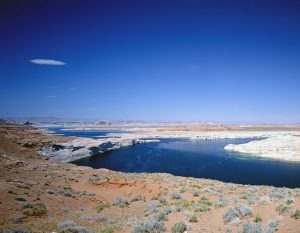I’m generally an optimist about our ability to solve our water problems of the western United States, but the drought of 2000-05 provides a boundary condition to my thinking.

Lake Powell, photo by Carol Highsmith, via Library of Congress
In my post-journalism life, one of the most interesting projects I’ve been working on is a study for/by/with Colorado’s West Slope basin roundtables of the risks of climate change and drought to Lake Powell, the largest reservoir in the Upper Colorado River Basin. John Carron at Hydros has been doing the heavy lifting, using the big Colorado River Simulation System model to simulate some sophisticated drought and climate change scenarios, looking at reservoir operation and conservation options needed to keep Lake Powell above elevation 3,525 feet above sea level. 3,525 is the critical point below which we start to lose the ability to generate power and, more importantly, risk busting the Upper Basin’s compact delivery obligations to the Lower Basin.
As a simple proof-of-principle test to help get a handle on the issues and communicate the risks, John also did a relatively simple what-if calculation: what if drought of 2000-05 repeated today? It’s a useful scenario because most of us working on the river today were around back then. We can remember it. Tony Davis did an excellent story this morning on the results:
[A] new study warns that the lake could virtually dry up in as few as six years if the region gets a repeat of the dry spell it experienced from 2000 to 2005.
That could cripple the ability of the Colorado River’s four Upper Basin states to deliver river water to the Lower Basin states of Arizona, California and Nevada, as they’re legally obligated to do.
And it would increase the likelihood of cutbacks in river water deliveries to Arizona, in particular.
Eric Kuhn, who’s leading the study, explained the problem. We started that last big drought with a nearly full Lake Powell:
“Today it’s about half full,” Kuhn said. “You can’t go into a drought like that today if it’s half full. Things will have to change in how we do business.”
The point of the study is to help develop contingency plans ahead of time, so we have the tools in place to manage Powell’s decline before it turns into a mud puddle.
A note on the art: The picture is from the Library of Congress’s collection of the work of photographer Carol Highsmith. Highsmith donated a bunch of her work to the the LoC, freely licensed, and it’s an awesome collection. Yay the commons.

It’s actually pretty good to have a recent drought to compare with the current one. Here in the Sacramento/SF Delta area, we only have 1977, and not many folks seem to remember that drought. Memory is the first step in planning…. so many old reports from the 1977 drought say “next time, let’s do this…” and no one did anything.